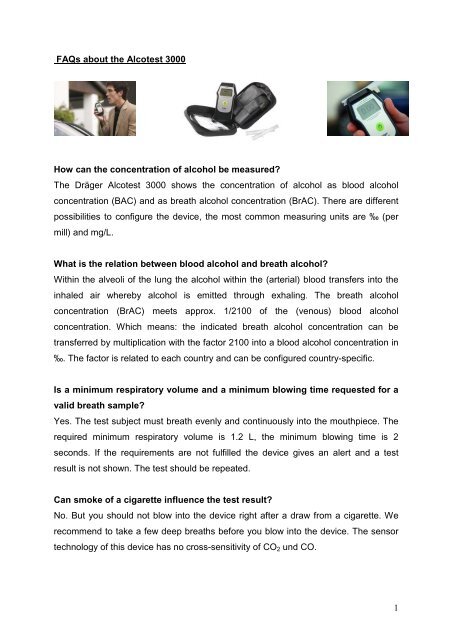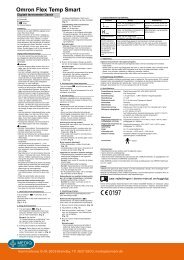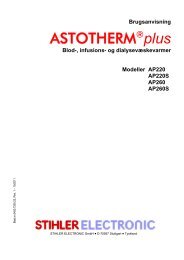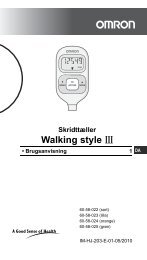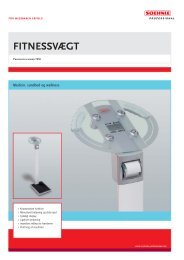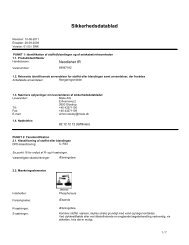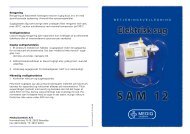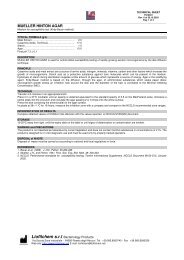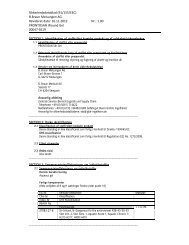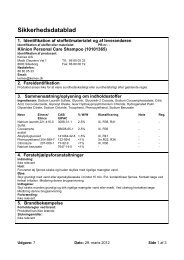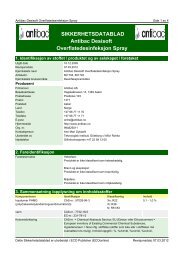1 FAQs about the Alcotest 3000 How can the concentration of ...
1 FAQs about the Alcotest 3000 How can the concentration of ...
1 FAQs about the Alcotest 3000 How can the concentration of ...
You also want an ePaper? Increase the reach of your titles
YUMPU automatically turns print PDFs into web optimized ePapers that Google loves.
<strong>FAQs</strong> <strong>about</strong> <strong>the</strong> <strong>Alcotest</strong> <strong>3000</strong><br />
<strong>How</strong> <strong>can</strong> <strong>the</strong> <strong>concentration</strong> <strong>of</strong> alcohol be measured?<br />
The Dräger <strong>Alcotest</strong> <strong>3000</strong> shows <strong>the</strong> <strong>concentration</strong> <strong>of</strong> alcohol as blood alcohol<br />
<strong>concentration</strong> (BAC) and as breath alcohol <strong>concentration</strong> (BrAC). There are different<br />
possibilities to configure <strong>the</strong> device, <strong>the</strong> most common measuring units are ‰ (per<br />
mill) and mg/L.<br />
What is <strong>the</strong> relation between blood alcohol and breath alcohol?<br />
Within <strong>the</strong> alveoli <strong>of</strong> <strong>the</strong> lung <strong>the</strong> alcohol within <strong>the</strong> (arterial) blood transfers into <strong>the</strong><br />
inhaled air whereby alcohol is emitted through exhaling. The breath alcohol<br />
<strong>concentration</strong> (BrAC) meets approx. 1/2100 <strong>of</strong> <strong>the</strong> (venous) blood alcohol<br />
<strong>concentration</strong>. Which means: <strong>the</strong> indicated breath alcohol <strong>concentration</strong> <strong>can</strong> be<br />
transferred by multiplication with <strong>the</strong> factor 2100 into a blood alcohol <strong>concentration</strong> in<br />
‰. The factor is related to each country and <strong>can</strong> be configured country-specific.<br />
Is a minimum respiratory volume and a minimum blowing time requested for a<br />
valid breath sample?<br />
Yes. The test subject must breath evenly and continuously into <strong>the</strong> mouthpiece. The<br />
required minimum respiratory volume is 1.2 L, <strong>the</strong> minimum blowing time is 2<br />
seconds. If <strong>the</strong> requirements are not fulfilled <strong>the</strong> device gives an alert and a test<br />
result is not shown. The test should be repeated.<br />
Can smoke <strong>of</strong> a cigarette influence <strong>the</strong> test result?<br />
No. But you should not blow into <strong>the</strong> device right after a draw from a cigarette. We<br />
recommend to take a few deep breaths before you blow into <strong>the</strong> device. The sensor<br />
technology <strong>of</strong> this device has no cross-sensitivity <strong>of</strong> CO2 und CO.<br />
1
Has <strong>the</strong> mouthpiece to be replaced after every breath test?<br />
For hygienic reasons, <strong>the</strong> mouthpiece should be replaced. In case <strong>of</strong> doing several<br />
breath tests in a short time period an increased condensation may occur. In this case<br />
you should make sure that <strong>the</strong> mouthpiece drys completely in <strong>the</strong> meantime.<br />
O<strong>the</strong>rwise it <strong>can</strong>’t be ruled out that <strong>the</strong> former positive test results will be transferred<br />
to <strong>the</strong> following test.<br />
Is <strong>the</strong>re a waiting period which has to be observed between <strong>the</strong> latest<br />
consumption <strong>of</strong> alcohol and <strong>the</strong> breath test sample?<br />
Remaining alcohol within <strong>the</strong> mouth may cause incorrect measurement values.<br />
Incorrect measurements <strong>can</strong> also happen after <strong>the</strong> test subject burps or vomits,<br />
drinks aromatic beverages (e.g. fruit juices) or uses alcoholc mouth spray. Therefore<br />
a waiting period <strong>of</strong> at least 15 minutes after drinking or eating s.th. should be kept.<br />
Has <strong>the</strong> <strong>Alcotest</strong> <strong>3000</strong> <strong>the</strong> same sensor technology like <strong>the</strong> pr<strong>of</strong>essional and<br />
more expensive breath alcohol measurement devices <strong>of</strong> Dräger?<br />
Yes, <strong>the</strong> measuring accuracy and <strong>the</strong> sensor technology are <strong>the</strong> same. But: <strong>the</strong><br />
measurement range and <strong>the</strong> operating temperature are limited. The CE marking<br />
“electromagnetic compatibility” (Directive 89/336/EEC) is also different. The CE<br />
marking is limited for residential and commercial environments. The <strong>Alcotest</strong> <strong>3000</strong><br />
has no data storage or an interface to a printer. It is designed for private use – for <strong>the</strong><br />
selftest – only.<br />
Accuracy <strong>of</strong> <strong>the</strong> <strong>Alcotest</strong> <strong>3000</strong>:<br />
The devices are adequat to a class 5%-device.<br />
Max. repeatability error with an ethanol standard<br />
0 to 1,0 ‰ - +/- 0,05 ‰ >1,00 ‰ - +/- 5 % <strong>of</strong> <strong>the</strong> measurement value<br />
0 to 0,540 ml/l - +/- 0,03 mg/L >0,50 mg/L - +/- 5 % <strong>of</strong> <strong>the</strong> measurement value<br />
Is it possible for <strong>the</strong> user to calibrate <strong>the</strong> <strong>Alcotest</strong> <strong>3000</strong>?<br />
Calibration <strong>can</strong> only be performed in an approved Draeger service workshop, since<br />
<strong>the</strong>re <strong>the</strong> needed equipment is available. For <strong>the</strong> calibration <strong>of</strong> <strong>the</strong> <strong>Alcotest</strong> <strong>3000</strong> <strong>the</strong><br />
AlcoView <strong>3000</strong> s<strong>of</strong>tware is required. For more information on <strong>the</strong> operation <strong>of</strong> <strong>the</strong><br />
s<strong>of</strong>tware, <strong>the</strong> service manual may be consulted in DORIS.<br />
2
<strong>How</strong> long is <strong>the</strong> life cycle <strong>of</strong> <strong>the</strong> electrochemical sensors in <strong>Alcotest</strong> devices?<br />
All EC sensors have a 1-year warranty. Our experiences show that <strong>the</strong> sensor may<br />
be replaced after 3-4 years. We also recommend to follow <strong>the</strong> specified service<br />
intervals to retain <strong>the</strong> measuring accuracy.<br />
<strong>How</strong> deviates <strong>the</strong> test results if <strong>the</strong> <strong>Alcotest</strong> <strong>3000</strong> will not be calibrated?<br />
There is every likelihood that <strong>the</strong> mentioned measuring tolerances will be exceeded.<br />
The longer a sensor is not calibrated <strong>the</strong> more inaccurate <strong>the</strong> measuring results will<br />
come up.<br />
Where <strong>can</strong> I buy <strong>the</strong> <strong>Alcotest</strong> <strong>3000</strong>?<br />
The <strong>Alcotest</strong> <strong>3000</strong> will be available in <strong>the</strong> regional sales <strong>of</strong>fices <strong>of</strong> Draeger. There<br />
also is <strong>the</strong> possibility to purchase <strong>the</strong> unit at selected technical specialty retailers,<br />
such as BBF, Trend Medic, Fricke, ACE and Mahsan.<br />
3


